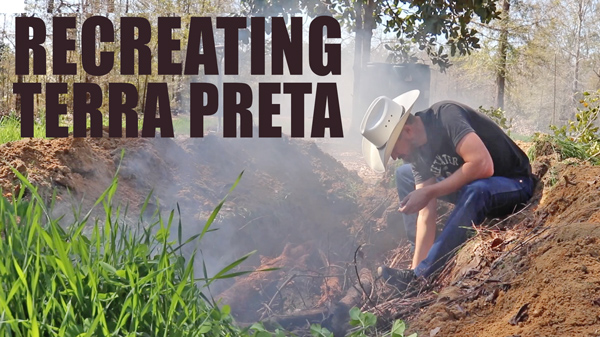Can you make terra preta in your backyard? I think so!
What is Terra Preta?
There are pockets of soil in the Amazon that differ from the poor soil around them. Called “terra preta,” this dark, carbon-rich soil has retained its fertility for centuries, but its origin is shrouded in mystery.
As Cornell University relates:
“Already at the end of the 19th century, Smith (1879) and Hartt (1885) reported the existence of dark earths in the Amazon, which had a dark color and were highly fertile. The origin of the Amazonian Dark Earths is not entirely clear and several conflicting theories were discussed in the past. Camargo (1941) speculated that these soils might have formed on fallout from volcanoes in the Andes, since they were only found on the highest spots in the landscape. Other theories included a formation as a result of sedimentation in Tertiary lakes (Falesi, 1974) or in recent ponds (Cunha-Franco, 1962). Further theories are mentioned by Smith (1980), which all did not hold against later investigations. It is now widely accepted that these soils were not only used by the local population but are a product of indigenous soil management as proposed by Gourou (1949). Later surveys confirmed these findings (Sombroek, 1966; Smith, 1980; Kern and Kämpf, 1989). Whether they were intentionally created for soil improvement or whether they are a by-product of habitation is not clear at present. This is in part due to the varied features of the dark earths throughout the Amazon Basin.”
There are patches of this super-rich soil that are 6-8′ deep. The yellow clay nearby is infertile and almost useless for farming – but terra preta soils support crops year after year. The evidence of terra preta being manmade is overwhelming, as there are bones and pottery shards throughout the soil, pointing to human intervention.
How Was Terra Preta Created?
Yet how did the Amazonians make terra preta? Was it created on purpose, or were they a side effect of long-term human habitation?
One could imagine pits being dug to dispose of waste, including leftovers, human excrement, broken pots and perhaps burned brush from clearing land. Or perhaps all wastes were burned in fires started on the surface of the ground and over centuries the soil built up beneath. Or perhaps terra preta was deliberately engineered, with bones, ashes, broken pottery and charcoal all playing specific roles in soil fertility.
Making Terra Preta
In my own garden, I am striving to recreate this mysterious soil by incorporating all the known ingredients together to see if I can also make soil that remains fertile for ages.
In my latest video – which is a long-form presentation – you’ll see the complete process of building a terra preta test bed and hear my reasoning behind it.
If this works, it may revolutionize gardening in poor soil. Even if it doesn’t last for centuries, it will certainly be the most nutrient-rich raised bed I have ever made.
Yet I think that fertility will stick around, thanks to the charcoal and the minerals added.
Here’s the link to my video. I think you’ll find it fascinating.
Will it make terra preta? Time will tell!



2 comments
This technique almost seems like lasagna gardening on steroids. The idea of layering many different sources of minerals and organic materials has always seemed like a really good way to ensure the soil has everything the plants might need. but adding in bio-char to act as a durable reservoir for nutrients and soil life, and doing the whole thing in a covered pit to prevent erosion, drying out, degredation by sunlight, etc, seems like it would lock in all that fertility and set it up for a long-term time-release of nutrients.
I can’t wait to see how the stuff you planted on that bed turned out. Do you think the uncharged biochar at the bottom will lock up a lot of the nutrients for the first couple years? Although there’s so much on top of it, plus the charged biochar, that by the time the most bio-available materials run out, maybe the bottom layer of biochar will have absorbed all it can and will start releasing nutrients back into the soil.
Tilhana ii would like to see if you had anything else you can say or tell me because i would liketo know more about layering minerals,etc
bubbieisback06@gmail.com
Comments are closed.